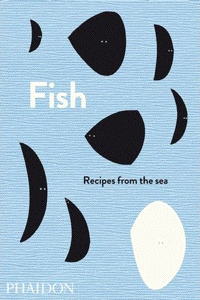
It’s easy to love the Silver Spoon‘s Fish: Recipes from the Sea (Phaidon 2012) for its design alone – from the abstract fish swimming on the cover on a blue sea by artist Katie Scott, to the straightforward organization by five fish types. But it is the recipes themselves, with matching photographs by Andy Sewell that will get you really hooked. The flavors are Italian and therefore well paired and well balanced, and the techniques aim to highlight those flavors. Even though it focuses on the fish found in Italian waters, these are fish found around the world.
 You’ll find basic techniques at the back of the book: Trimming, Scaling and Cleaning (pp. 288-9) has both descriptions and seven helpful photographs. Step-by-step instruction son follows that how to fillet and skin different types of fish: Round Fish (pp290-1), Flat Fish (pp. 292-3), Monkfish (pp. 294-5) and so on.
You’ll find basic techniques at the back of the book: Trimming, Scaling and Cleaning (pp. 288-9) has both descriptions and seven helpful photographs. Step-by-step instruction son follows that how to fillet and skin different types of fish: Round Fish (pp290-1), Flat Fish (pp. 292-3), Monkfish (pp. 294-5) and so on.
Turning to the front of the book, the first chapter is on Round Fish. The first few pages profile each of the most popular fish with a pretty photo and a description, where it is fished, how to prepare it, and what to look for at the fishmongers. Sea Bass, called Branzino in Italy, is the first fish:
Often compared to sea bream in texture and flavour, sea bass has a dense covering of small scales, a gleaming silver bell, and a well-deserved reputation for its white, lean and delicate flesh. (p. 15)
Grey/Striped Mullet, Grouper, Monkfish, Cod and others are described. The first six recipes are for sea bas: Baked Sea Bass with Artichokes (p. 26) can also be made with sea bream, trout, or gray (striped) mullet. The fish is stuffed with garlic, and the roasted in the oven with white wine and baby globe artichokes. Sea Bass Baked in Paper (p. 26) includes garlic, onion, rosemary, and wine. Not all the sea bass recipes work with the same fish. For instance, Sea Bass Carpaccio with Salmoriglio (p. 29) works with salmon or sea bream, while Sea Bass with Pomegranates (p. 30) works with grouper or grey (striped) mullet. Finally, Sea Bass Ravioli (p. 31) stuffed with fish, mascarpone, and chives, would work well with crab, salmon, or hake.
Each chapter explores pastas, soups, grilled fish, and fish salads. There is even a recipe for Fritto Misto (p. 175), the wonderful fried mixed seafood dish that Italians love. At the end of the seafood chapter is a recipe for Crab Cakes (p. 250) that substitutes potato for mayonnaise usually found in the typical Maryland variety.
Fish marries fine recipes with a detailed guide to fish. You never know when you might need to filet a monkfish, prepare a recipe with monkfish, or simply choose a good fish at the market. Fish will help you through it all.

1 comments on “Silver Spoon: Fish”